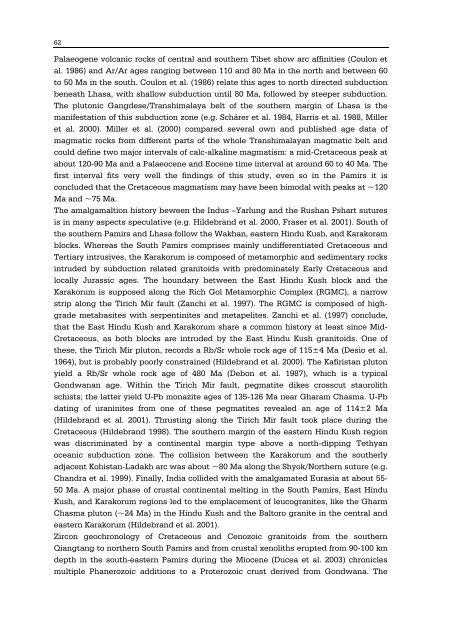tübinger geowissenschaftliche arbeiten (tga) - TOBIAS-lib ...
tübinger geowissenschaftliche arbeiten (tga) - TOBIAS-lib ...
tübinger geowissenschaftliche arbeiten (tga) - TOBIAS-lib ...
Create successful ePaper yourself
Turn your PDF publications into a flip-book with our unique Google optimized e-Paper software.
62<br />
Palaeogene volcanic rocks of central and southern Tibet show arc affinities (Coulon et<br />
al. 1986) and Ar/Ar ages ranging between 110 and 80 Ma in the north and between 60<br />
to 50 Ma in the south. Coulon et al. (1986) relate this ages to north directed subduction<br />
beneath Lhasa, with shallow subduction until 80 Ma, followed by steeper subduction.<br />
The plutonic Gangdese/Transhimalaya belt of the southern margin of Lhasa is the<br />
manifestation of this subduction zone (e.g. Schärer et al. 1984, Harris et al. 1988, Miller<br />
et al. 2000). Miller et al. (2000) compared several own and published age data of<br />
magmatic rocks from different parts of the whole Transhimalayan magmatic belt and<br />
could define two major intervals of calc-alkaline magmatism: a mid-Cretaceous peak at<br />
about 120-90 Ma and a Palaeocene and Eocene time interval at around 60 to 40 Ma. The<br />
first interval fits very well the findings of this study, even so in the Pamirs it is<br />
concluded that the Cretaceous magmatism may have been bimodal with peaks at ~120<br />
Ma and ~75 Ma.<br />
The amalgamaltion history beween the Indus –Yarlung and the Rushan Pshart sutures<br />
is in many aspects speculative (e.g. Hildebrand et al. 2000, Fraser et al. 2001). South of<br />
the southern Pamirs and Lhasa follow the Wakhan, eastern Hindu Kush, and Karakoram<br />
blocks. Whereas the South Pamirs comprises mainly undifferentiated Cretaceous and<br />
Tertiary intrusives, the Karakorum is composed of metamorphic and sedimentary rocks<br />
intruded by subduction related granitoids with predominately Early Cretaceous and<br />
locally Jurassic ages. The boundary between the East Hindu Kush block and the<br />
Karakorum is supposed along the Rich Gol Metamorphic Complex (RGMC), a narrow<br />
strip along the Tirich Mir fault (Zanchi et al. 1997). The RGMC is composed of highgrade<br />
metabasites with serpentinites and metapelites. Zanchi et al. (1997) conclude,<br />
that the East Hindu Kush and Karakorum share a common history at least since Mid-<br />
Cretaceous, as both blocks are intruded by the East Hindu Kush granitoids. One of<br />
these, the Tirich Mir pluton, records a Rb/Sr whole rock age of 115±4 Ma (Desio et al.<br />
1964), but is probably poorly constrained (Hildebrand et al. 2000). The Kafiristan pluton<br />
yield a Rb/Sr whole rock age of 480 Ma (Debon et al. 1987), which is a typical<br />
Gondwanan age. Within the Tirich Mir fault, pegmatite dikes crosscut staurolith<br />
schists; the latter yield U-Pb monazite ages of 135-126 Ma near Gharam Chasma. U-Pb<br />
dating of uraninites from one of these pegmatites revealed an age of 114±2 Ma<br />
(Hildebrand et al. 2001). Thrusting along the Tirich Mir fault took place during the<br />
Cretaceous (Hildebrand 1998). The southern margin of the eastern Hindu Kush region<br />
was discriminated by a continental margin type above a north-dipping Tethyan<br />
oceanic subduction zone. The collision between the Karakorum and the southerly<br />
adjacent Kohistan-Ladakh arc was about ~80 Ma along the Shyok/Northern suture (e.g.<br />
Chandra et al. 1999). Finally, India collided with the amalgamated Eurasia at about 55-<br />
50 Ma. A major phase of crustal continental melting in the South Pamirs, East Hindu<br />
Kush, and Karakorum regions led to the emplacement of leucogranites, like the Gharm<br />
Chasma pluton (~24 Ma) in the Hindu Kush and the Baltoro granite in the central and<br />
eastern Karakorum (Hildebrand et al. 2001).<br />
Zircon geochronology of Cretaceous and Cenozoic granitoids from the southern<br />
Qiangtang to northern South Pamirs and from crustal xenoliths erupted from 90-100 km<br />
depth in the south-eastern Pamirs during the Miocene (Ducea et al. 2003) chronicles<br />
multiple Phanerozoic additions to a Proterozoic crust derived from Gondwana. The

















